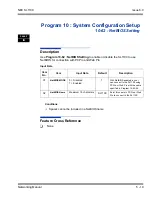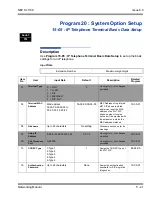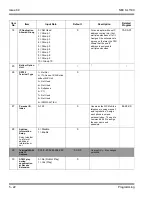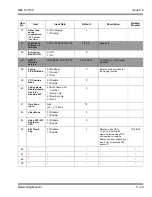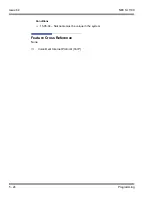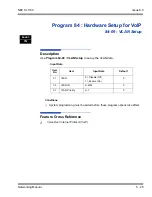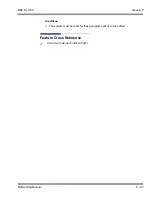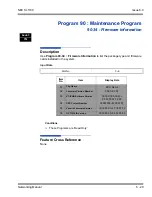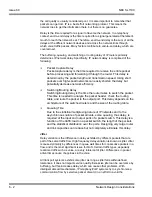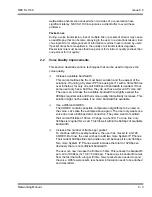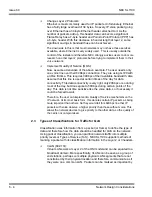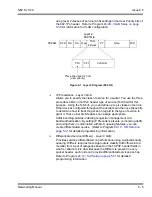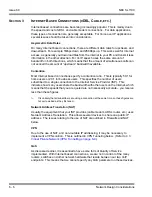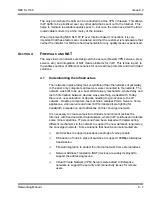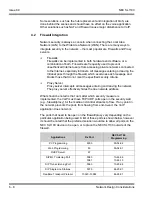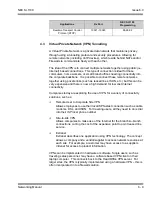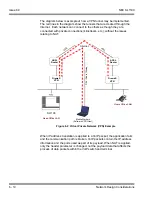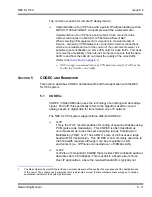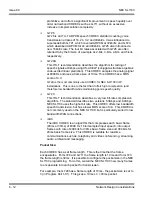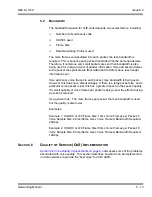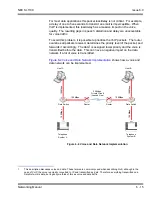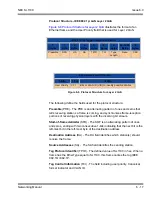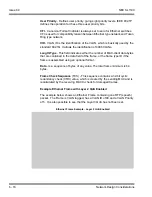
NEC SL1100
Issue 6.0
Networking Manual
6 - 3
walkie-talkie phenomenon caused when two sides of a conversation have
significant latency. NEC SL1100 incorporates a Jitter Buffer to avoid these
problems.
Packet Loss
During a voice transmission, loss of multiple bits or packets of stream may cause
an audible pop that can become annoying to the user. In a data transmission, loss
of a single bit or multiple packets of information is almost never noticed by users.
If packet drops become epidemic, the quality of all transmissions degrades.
Packet loss rate must be less than five percent for minimum quality and less than
one percent for toll quality.
2.2
Voice Quality Improvements
This section describes various techniques that can be used to improve the
voice quality.
Increase available bandwidth:
This can sometimes be the most basic solution and the easiest of the
solutions. If running a System IP Phone using G.711 with a 30ms fill time
over Ethernet, for only one call, 90Kbps of bandwidth is needed. If that
same user only has a 64K line, they do not have a decent IP voice call.
The user can increase the available bandwidth to slightly exceed the
90Kbps requirements and their voice quality dramatically increases. This
solution might not be viable if no more bandwidth is available.
Use a different CODEC:
The CODEC contains possible compression algorithms to be used on
the voice. Let’s take the example above again. The user only wants one
voice line over a 64Kbps data connection. They also want to maintain
their current fill time of 30ms. Change to a G.729. For one line, only
34Kbps is required for a call. This fits well within the 64Kbps of available
bandwidth.
Increase the number of frames per packet:
To continue with the example above, the user has moved to a G.729
CODEC. But now, the user wishes to add two more System IP Phones.
Their current 64Kbps line can handle one call, because it is only 34Kbps.
Two more System IP Phones would increase the total to 102Kbps so
obviously there is not sufficient bandwidth.
The user can now increase the fill time to 50ms. This reduces the bandwidth
per call to 19.8Kbps (3x 19.8 = 59.4Kbps). The savings in bandwidth comes
from the fact that with a longer fill time, fewer packets are needed to send
the voice. With fewer packets, less header information needs to be attached
and transmitted.
Содержание SL1100
Страница 1: ...Networking Manual NDA 31190 Issue 6 0 SL1100...
Страница 2: ......
Страница 4: ......
Страница 22: ...Issue 6 0 NEC SL1100 1 2 Introduction THIS PAGE INTENTIONALLY LEFT BLANK...
Страница 62: ...Issue 6 0 NEC SL1100 5 30 Programming THIS PAGE INTENTIONALLY LEFT BLANK...
Страница 81: ...NEC SL1100 Issue 6 0 Networking Manual 6 19 Ethernet Frame Example Layer 2 QoS Enabled Continued...
Страница 94: ...Issue 6 0 NEC SL1100 6 32 Network Design Considerations THIS PAGE INTENTIONALLY LEFT BLANK...
Страница 134: ...Issue 6 0 NEC SL1100 8 10 DHCP Client THIS PAGE INTENTIONALLY LEFT BLANK...
Страница 159: ...NEC SL1100 Issue 6 0 Networking Manual 9 25 Figure 9 7 Log In to IP Phone...
Страница 181: ...NEC SL1100 Issue 6 0 Networking Manual 9 47 Figure 9 25 IP System Operation Setup...
Страница 206: ...Issue 6 0 NEC SL1100 9 72 IP Multiline Station SIP Figure 9 36 NAPT Configuration Example...
Страница 230: ...Issue 6 0 NEC SL1100 10 18 IP Single Line Telephone THIS PAGE INTENTIONALLY LEFT BLANK...
Страница 232: ...Issue 6 0 NEC SL1100 11 2 NAPT Figure 11 1 NAPT Configuration Example...
Страница 242: ...Issue 6 0 NEC SL1100 12 4 All DSP Busy Indication THIS PAGE INTENTIONALLY LEFT BLANK...
Страница 290: ...Issue 6 0 NEC SL1100 13 48 SL Net THIS PAGE INTENTIONALLY LEFT BLANK...
Страница 291: ......
Страница 292: ...SL1100 Networking Manual NEC Corporation of America Issue 6 0...

